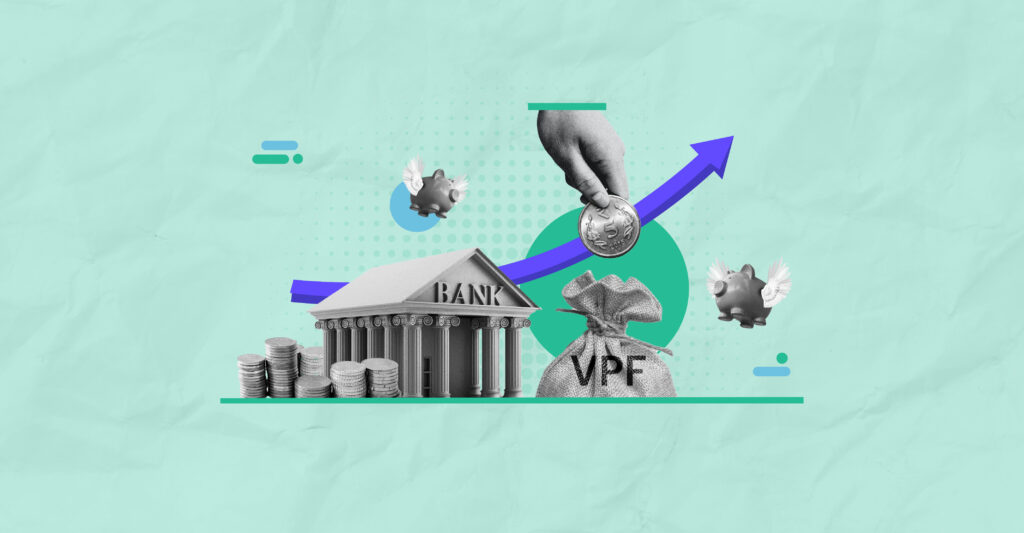Last Updated on Jul 25, 2022 by
Retirement is an important phase of one’s life. Saving for retirement from the start of your career will ensure you have enough money to live a financially stress-free life. Voluntary Provident Fund (VPF) is one such savings scheme wherein employees contribute to the scheme voluntarily. Like other Provident Fund (PF) categories, VPF is also backed by the Government of India. The scheme caters to investors with a low-risk appetite. In this article, let’s discuss all about the Voluntary Provident Fund.
Table of Contents
What is VPF?
Unlike a few PF schemes where employers and employees contribute a small portion to the funds, in the VPF, employers are under no obligation to contribute. Only an employee will contribute a portion of their salary towards the scheme. Though employees are also under no obligation to contribute to the VPF, once the scheme is initiated, they cannot discontinue or terminate it before completing the minimum tenure of 5 yrs.
The maximum contribution an employee can make towards the VPF scheme is 100% of their salary. It is an extension of the Employee Provident Fund (EPF). Therefore, the contribution towards VPF will be deducted from the salary in addition to the EPF contribution of 12%.
VPF interest rate in 2022
The interest rate of the Voluntary Provident Fund for the FY 2021 – 2022 is 8.1%. The Government of India decides it at the start of each financial year.
Benefits of the Voluntary Provident Fund
VPF is a safe and long-term investment option for the salaried class. Here are the benefits of the scheme.
- The employee’s contribution towards VPF is eligible for a tax deduction, while the interest income and the returns are non-taxable given that the minimum tenure of 5 yrs is completed.
- The scheme is managed by the Government of India, which makes it one of the safest investment options.
- The interest rate offered is high.
- During a job change, VPF contributors can shift their account from one employer to another easily.
- In case of death of the account holder, the legal heir or the nominee will get the whole amount.
Eligibility for the VPF
Salaried individuals working in the organised sector and employers registered with Employees’ Provident Fund Organisation (EPFO) are eligible for a VPF account. Therefore, individuals working in unorganised sectors or self-employed are not eligible for this scheme.
How to open a VPF account?
Enrolling on the VPF scheme is a simple process. As it is an extension to the EPF, you can request your employer to enrol you for the VPF. You need to submit the VPF form to your employer. The form contains your personal and employment details along with the monthly contribution percentage you want to make towards the scheme. The percentage you mention on the form will be debited from your basic salary and dearness allowance.
Once you submit the VPF form to the employer, they will take the request forward after verifying the details.
VPF withdrawal rules
The withdrawal rules for Voluntary Provident Fund are as follows:
- The lock-in period of the VPF account is 5 yrs. Once the contributor retires or resigns from the employment, the accumulated funds are paid.
- The contributor is allowed to withdraw the funds partially or fully in the case of financial emergencies. In such cases, the withdrawal amount is subject to taxation.
- At the demise of the account holder, the nominee will receive the accumulated funds.
VPF tax benefits
The tax benefits of the Voluntary Provident Fund are as follows:
- The contributions made towards the scheme are eligible for tax deductions under Section 80C of the Income Tax Act, 1961, subject to the maximum limit of Rs.1.5 lakh.
- The interest amount on the VPF scheme is non-taxable.
- Returns are also non-taxable if you withdraw the funds after the lock-in period of 5 yrs.
VPF calculator
While making a long-term investment, it is advised to calculate the final returns to plan further wisely. You can calculate your potential returns using the VPF calculator online. The details you need while calculating the VPF investment are as follows:
- Percentage of salary contributed to the fund
- Interest rate. Note that this keeps changing every financial year
- Current EPF balance
How to withdraw funds from the VPF account?
In the case of emergencies, the contributor can withdraw the funds from the VPF account. The withdrawal process is as follows:
- Fill the Form 31. You can get the form from your employer or download it on the EPFO portal.
- Keep the documents like bank details, PF number, postal address and a cancelled cheque handy.
- Self-attest the documents.
- Log in to your EPF account on the EPFO portal using the Universal Account Number (UAN) and password.
- Submit the documents online.
- Your employer and the EPFO official will verify the details and credit the requested amount to your bank account.
VPF vs EPF vs PPF
VPF, EPF, and Public Provident Fund (PPF) are government-backed saving schemes which contribute to the retirement fund; Here are a few differences of each scheme.
| Features | VPF | EPF | PPF |
| Who can open the account? | Salaried Indian resident | Salaried Indian resident | Any Indian (NRIs not eligible) |
| Employer’s contribution | Not applicable | 12% of the basic salary | Not applicable |
| Account holder’s contribution | Up to 100% of the salary | 12% of the basic salary | Minimum Rs. 500 per annum |
| Investment tenure | Upon retirement or resignation | Upon retirement or resignation | 15 yrs |
| Tax on returns | Tax-free | Tax-free | Tax-free |
FAQs
1. Is VPF taxable?
The contributions made, interest rate and the returns on the VPF scheme are tax-free. However, the returns are tax-free only if you withdraw the funds after the minimum tenure of 5 yrs.
2. How to check VPF balance?
You can check the VPF balance online. Log in to the EPFO portal with your UAN to find the details of your VPF account.
3. What is the Voluntary Provident Fund contribution?
The maximum VPF contribution is 100% of your salary, while the minimum contribution is anything as per your choice beyond the 12% EPF contribution.
4. Will my VPF get closed if I change my job?
No. Your VPF account is linked to your Aadhaar card. Therefore, when you change your job from one organisation to another, your VPF account will also transfer.
- Best Passive Mutual Funds in India: Top Index Options for 2025 - Mar 28, 2025
- Best Short-Term Mutual Funds in India for 2025 - Mar 28, 2025
- List of Top Small Cap Funds India for 2025 - Mar 27, 2025




